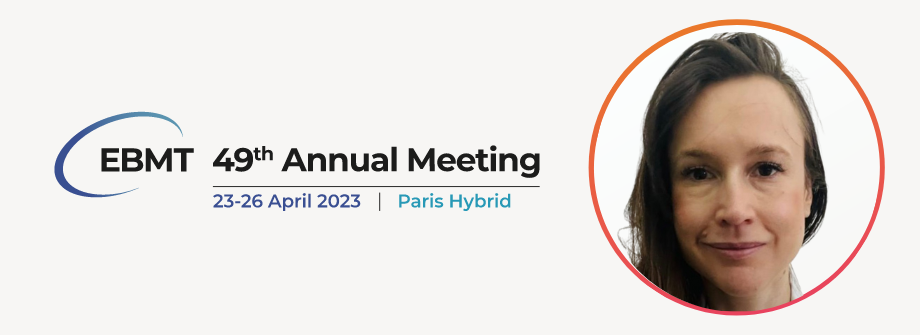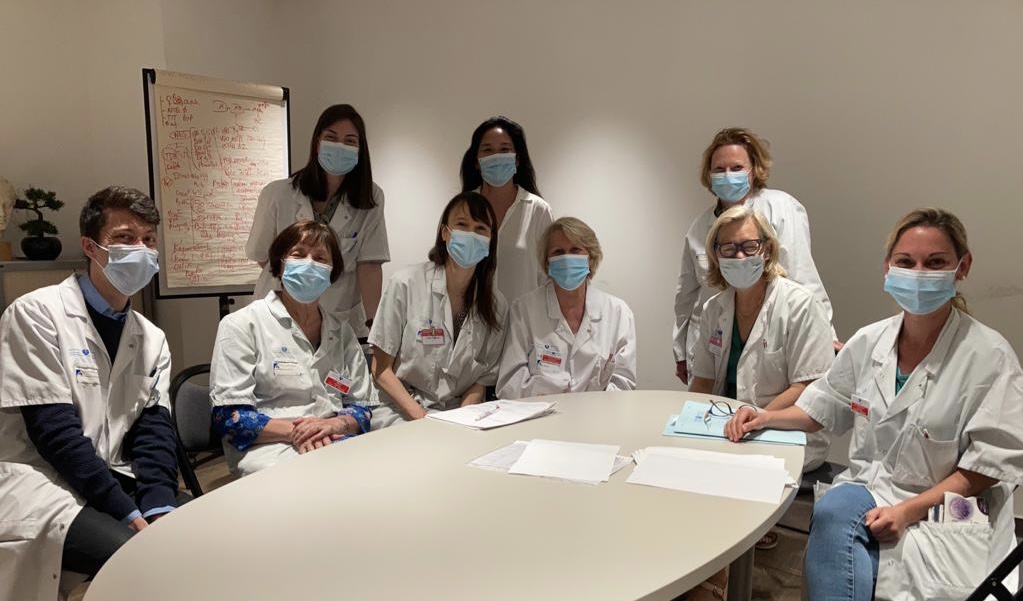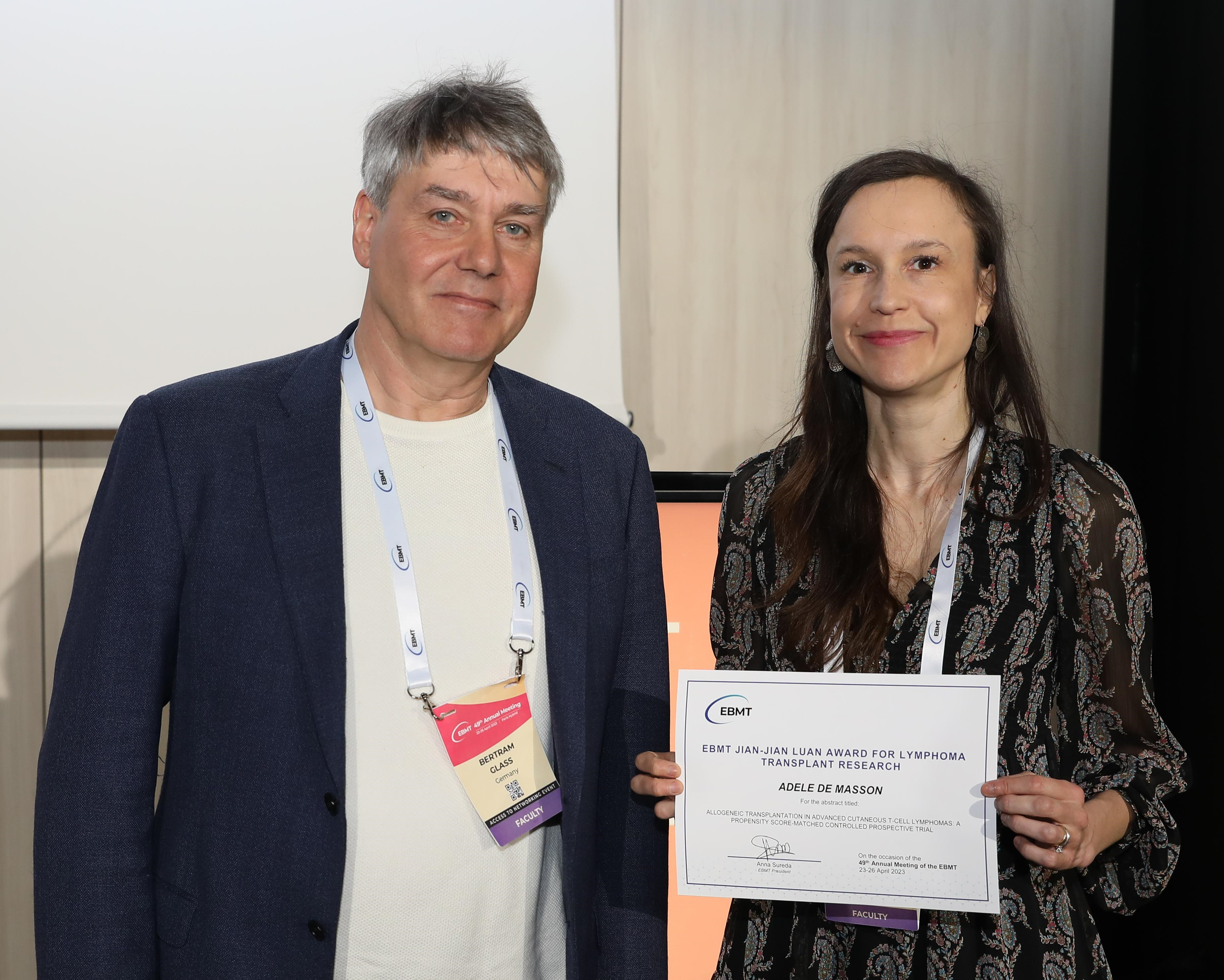
Time and date of presentation: 11:15-11:30, Tuesday 25 April, Room 143, part of Lymphoma Working Party Session.
Adèle de Masson is the winner of this year’s Jian Jian Luan award for her study 'ALLOGENEIC TRANSPLANTATION IN ADVANCED CUTANEOUS T-CELL LYMPHOMAS: A PROPENSITY SCORE-MATCHED CONTROLLED PROSPECTIVE TRIAL'
Click here to view full abstract
Note: the full study was published in The Lancet on Monday 24 April 2023: Allogeneic transplantation in advanced cutaneous T-cell lymphomas (CUTALLO): a propensity score matched controlled prospective study
Here Adèle tells us about her career so far, and why she decided to do this study.
Q: Please tell us a bit about yourself, for those delegates who don’t know you?
A: I am 38 years old, and I am a dermatologist, oncologist, and Professor at Université Paris Cité. During my residency, I have worked 6 months in the department of Hematology and Bone Marrow Transplantation at Saint Louis Hospital in Paris (previous Chairman was Professor Gérard Socié), and with the current head of department of dermatology at Saint-Louis hospital, Jean-David Bouaziz, we have developed a strong collaboration with haematologists.
After a post-doctoral fellowship in the Department of Dermatology at Dana Farber/Brigham and Women’s Cancer Center, Harvard Medical School, focusing on cutaneous T-cell lymphomas (CTCL) under the supervision of Tom Kupper, I am currently working in the Department of Dermatology at Saint-Louis Hospital in Paris (national reference center for cutaneous lymphomas) since 2017.
My clinical activity focuses on cutaneous lymphomas and inflammatory skin diseases. I dedicate my research to the identification, development and evaluation of new biomarkers and therapeutic targets in CTCL.
Q: Why did you decide to do this study?
Our hospital is the national reference center for cutaneous lymphomas - it is the coordinating center of the GFELC (Groupe Français d'Etude des Lymphomes Cutanés) - French Study Group on Cutaneous Lymphomas, a reference network of 42 centers in France, Switzerland and Belgium. My previous head of Department, Prof Martine Bagot, also a dermatologist, is a key opinion leader in the field and passed on her passion for cutaneous lymphoma research. We treat many patients with cutaneous lymphomas and I remember taking care of some of these patients with advanced CTCL during my dermatology residency.
CTCL are a heterogenous group of non-Hodgkin lymphomas of which mycosis fungoides (MF) is the most common subtype. While patients with stage IA-IIA (early-stage) disease have 5-year overall survival rates ranging from 78 to 94%, progression to advanced stage is associated with median overall survival <5 years. These diseases can be quite devastating, not only because of the frequent hospital stays, asthenia and side effects of the treatments, but also because they induce visible skin changes, pruritus, and skin pain. Some of my patients were almost unrecognisable, and were afraid to see their grandchildren and scare them.
When I was a resident in the department of Hematology and Bone Marrow Transplantation at Saint Louis Hospital in Paris, with Prof Régis Peffault de Latour (current head of the Hematology and Bone Marrow Transplant Unit at Saint-Louis Hospital), the GFELC and the SFGM-TC (Société Française de Greffes de Moelle et Thérapie Cellulaire), back in 2014, we did a French retrospective study on allogeneic haematopoietic stem cell transplantation in cutaneous T-cell lymphomas (CTCL). We noticed, like many of our colleagues, that some patients had long-term remissions of their lymphoma after transplant, without specific treatment of the lymphoma. This is exceptional in advanced cutaneous T-cell lymphomas. However, because the patients who had received transplant were highly selected (they were "fit", and had achieved, in most cases, at least partial response before transplant), and because there was no control group, it was difficult to draw firm conclusions about the effect of transplant on the disease. Régis Peffault de Latour had the idea to set up a prospective controlled study, and our team agreed it was a good idea.
I thank him very much, as well as Prof Sylvie Chevret, the biostastician in this study, and all the dermatologists from the GFELC (including Dr Caroline Ram-Wolff, dermatologist, who is the medical coordinator of the network) and haematologists from the SFGM-TC, who actively participated during the 9 years of the study. CTCL are rare diseases, and enrolling enough patients in clinical trials is always a challenge, so it is great to have dynamic groups in the field.
Q: What were the main findings?
A: In this prospective, multicentre, matched controlled trial, patients with advanced CTCL were allocated treatment according to the availability of a compatible related donor and assigned to allogeneic HSCT or non-allogeneic HSCT therapy. Propensity score matching with replacement was used to handle confounding factors, with balance assessed using standardised mean differences.
The primary endpoint was progression-free survival. In the intention-to-treat analysis, the primary endpoint was met: median progression-free survival was significantly longer in the HSCT group versus the non-HSCT group: 9·0 months versus 3·0 months with a hazard ratio (HR) of 0·38 (95% CI 0.21– 0.69; p<0.0001). Median overall survival was not reached in the matched HSCT group and was 27 months (95% CI 16.1–NA) in the matched non-HSCT group (HR 0.54, 95% CI 0.23–1.29). There was also a mean improvement in EORTC-QLQ-C30 quality-of-life measurements over time in the HSCT group.
Q: What are the implications for the findings, and will you be following up the study?
A: Allogeneic HSCT was associated with significantly longer progression-free survival in patients with advanced-stage CTCL. This suggests the existence of a graft-versus-lymphoma effect in CTCL. This study calls for a larger access to allogeneic HSCT for patients with advanced CTCL. Although quality of life was a secondary endpoint in this study, it is an important consideration, since HSCT recipients in complete remission of the lymphoma may suffer from chronic GVHD which can considerably impair their quality-of-life.
The study was not powered to detect difference in outcomes between different stages, or between patients with mycosis fungoides and Sézary syndrome, so the optimal timing of transplant during the disease course remains uncertain. The post-transplant relapse rate was also quite high, and most relapses occurred in skin. Thus we would like to compare different conditioning regimen, including pre-transplant total skin electron-beam therapy, to potentially lower the incidence of skin relapses. Post-transplant maintenance treatments also need to be evaluated in this setting.
Q: What other projects are you involved in?
A: We have a very active team in the field of CTCL research at Saint-Louis hospital, within the GFELC network, and with European and international collaborators, and I feel very grateful for that. We are currently developing a multicentre project aiming at using artificial intelligence (neural networks) to predict prognosis in early-stage CTCL.
In fact, most patients with early-stage CTCL will experience life-long indolent disease, and a minority of them will progress to advanced stage. There is no clear understanding of the determinants of disease progression. Advanced stage CTCL are often refractory to treatment. The low response rate to current treatments in advanced-stage disease, and the unacceptable cost and potential side-effects of transplant in the ~80% of early-stage patients who will not progress, highlight the need for early identification of the patients who will progress, in order to prioritize these patients for transplant and achieve complete remission before the disease has become treatment-refractory.
The other issue we face is the difficulty to achieve complete remission for transplant in advanced-stage CTCL. Indeed, we and others have observed that pre-transplant complete or very good partial responses of the lymphoma were associated with better outcomes.
But as previously mentioned, advanced-stage CTCL are associated with overall response rates to current systemic treatments of around 40%. Only 2 systemic treatments, mogamulizumab and brentuximab vedotin, have shown efficacy in randomised controlled trials and are currently FDA- and EMA-approved, making it extremely difficult to achieve the complete response needed for transplant success.
We need new effective and well-tolerated treatments, and the main focus of our laboratory is to identify therapeutic targets, and collaborate with industry to bring them to the clinic in CTCL. With our colleagues from INSERM (Armand Bensussan, Jérome Giustiniani, Hélène Moins-Teisserenc, Maxime Battistella, among others) we have recently patented 8 potential new targets, and are actively working to launch early phase clinical trials in CTCL, to add new options to our therapeutic arsenal, with the final aim, potentially, to cure more patients.
Q: Tell us what you like to do outside of work.
A: It may not seem very fancy but I like books - especially novels and biographies- libraries and bookshops are among my favorite places, Although now that I have a 2-year-old daughter, the only books I manage to complete reading are almost exclusively children's books!
Q: Thank you Adèle, and have a nice congress!
A: Thank you - and again thanks very much to all the people involved, including the patients.


(EBMT Lymphoma Working Party Chair); Adèle de Masson